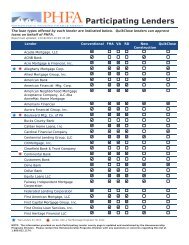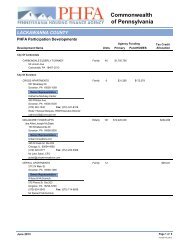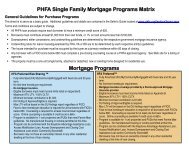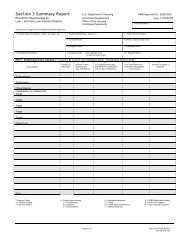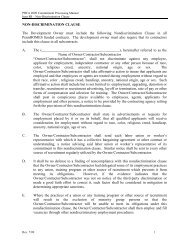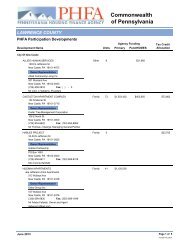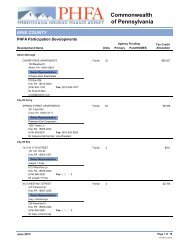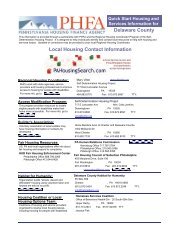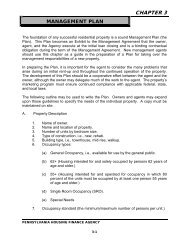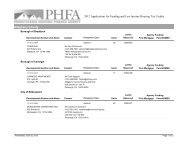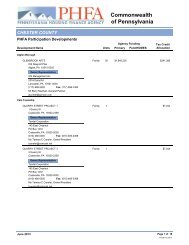PHFA Annual Report 2003 - Pennsylvania Housing Finance Agency
PHFA Annual Report 2003 - Pennsylvania Housing Finance Agency
PHFA Annual Report 2003 - Pennsylvania Housing Finance Agency
You also want an ePaper? Increase the reach of your titles
YUMPU automatically turns print PDFs into web optimized ePapers that Google loves.
44 45<br />
<strong>PHFA</strong> has presented the statement of cash flows using the direct method as required by Statement No. 34. A reconciliation<br />
of net income to net cash provided from operating activities is also shown.<br />
Investment Securities<br />
The <strong>Agency</strong> values its investments in accordance with GASB Statement No. 31, Accounting and Financial <strong>Report</strong>ing for<br />
Certain Investments and for External Investment Pools, which requires the investments to be carried in the Statement of<br />
Net Assets at their fair value.<br />
The fair value of the <strong>Agency</strong>’s investment securities are based upon values provided by external investment managers and<br />
quoted market prices.<br />
Mortgage Loans Receivable and Construction Advances<br />
Mortgage loans receivable and construction advances are carried at amounts disbursed plus accrued interest and fees, less<br />
collections, mortgage loan discounts and allowance for potential loan losses, if any. The current portion of loans receivable<br />
represents the contractual amount due within the next year.<br />
Allowance for Potential Loan Losses<br />
The allowance for potential loan losses is determined based upon management’s evaluation of mortgage loans receivable<br />
and construction advances. Factors considered by management include the estimated fair market values of the properties<br />
that represent collateral, the amount of mortgage insurance to be received, if any, the past experience and financial condition<br />
of the borrowers, and the economy. While management uses available information to recognize losses on loans, future<br />
additions to the allowance may be necessary based on changes in economic conditions. Additions to the allowance are provided<br />
by charges to expense.<br />
Real Estate Owned<br />
During the normal course of business, the <strong>Agency</strong> purchases single family properties at foreclosure proceedings to avoid or<br />
minimize losses on mortgage loans. These properties are recorded at the lower of cost or market value. Costs incurred subsequent<br />
to foreclosure which are directly related to the sale or improvement of the real estate are capitalized to the extent<br />
they enhance the value of the property. At the time of foreclosure, losses are charged to the allowance for loan losses.<br />
Subsequent losses are charged to other expense as incurred. Real estate owned is included in other assets on the statement<br />
of net assets.<br />
Interfund Accounts Receivable (Payable)<br />
To meet liquidity requirements of individual funds, the <strong>Agency</strong> transfers funds to and from the separate enterprise funds.<br />
Deferred and Other Assets<br />
Deferred assets relate to bond issuance costs, loan origination costs, and other assets. The <strong>Agency</strong> capitalizes expenses related<br />
to bond issuances and amortizes these expenses over the contractual life of the bonds using the constant yield method.<br />
The <strong>Agency</strong> capitalizes the costs of originating multifamily housing projects, net of fees realized, and amortizes these fees<br />
over 25 years, the average life of multifamily loans. Other assets relate primarily to furniture and fixtures owned by the<br />
<strong>Agency</strong> which are amortized over their useful life.<br />
Restricted Net Assets<br />
Investments classified as restricted are those investments which may only be expended by the <strong>Agency</strong> within the guidelines<br />
of the outstanding bond indentures.<br />
Unrestricted Net Assets<br />
Unrestricted net assets are those assets not restricted by bond indentures. The Board of Directors of the <strong>Agency</strong> internally<br />
designates these assets for specific loan programs and to meet the recurring business needs of the <strong>Agency</strong>.<br />
Mortgage Loan Interest<br />
Interest income is recognized over the life of construction advances and mortgage loans receivable based upon the constant<br />
yield method.<br />
Mortgage Loan Origination Fees and Costs<br />
Loan origination fees range from 1 percent to 2.5 percent of the loan commitment for the Multi- Family Program and<br />
from 0 percent to 1 percent of the mortgage amount for the Single Family Program. The Single Family loan origination<br />
fees are retained by the financial institutions which originate <strong>Agency</strong> loans.<br />
Loan origination costs relate to investigations, surveys, appraisals and direct salaries pertaining to the evaluation of mortgage<br />
loan proposals and construction advances.<br />
Amortization of Notes and Bonds Payable Discounts<br />
Underwriter discounts relating to notes and bonds payable, including original issue discounts, are amortized over the lives<br />
of the related debt using the effective interest method.<br />
Deferred Gain<br />
In prior years, in an effort to maintain the low-income status of various multi-family projects, the <strong>Agency</strong> acquired these<br />
projects, at below market value, from the original owners. The <strong>Agency</strong> in turn sold these properties, at market price, to the<br />
current owners with the condition that they would retain their low-income status.<br />
The deferred gain (the excess of the selling price over the <strong>Agency</strong>’s acquisition price) is included in escrow and other liabilities<br />
and is being amortized over the lives of the current owners’ mortgage loans using the installment method.<br />
Deferred Costs of Refunding<br />
The <strong>Agency</strong> follows GASB Statement No. 23, Accounting and Financial <strong>Report</strong>ing for Refundings of Debt <strong>Report</strong>ed by<br />
Proprietary Activities, which requires that the difference between the reacquisition price and the net carrying amount of<br />
defeased debt be deferred and amortized as a component of interest expense over the remaining life of the old debt or the<br />
life of the new debt, whichever is shorter. On the balance sheet, the amount of the unamortized deferred costs of refunding<br />
is reported as a deduction from or addition to the new debt. During the years ended June 30, <strong>2003</strong> and 2002, the<br />
<strong>Agency</strong> deferred losses of $0 and $5,260, respectively, on the refunding of Single Family Mortgage Revenue Bonds. As of<br />
June 30, <strong>2003</strong> and 2002, the unamortized Single Family deferred costs of refunding are $15,051 and $16,002, respectively.<br />
Additionally, during the years ended June 30, <strong>2003</strong> and 2002, the <strong>Agency</strong> deferred losses of $5,135 and $0, respectively,<br />
on refunding Multi-Family Mortgage Revenue Bonds. As of June 30, <strong>2003</strong> and 2002, the unamortized Multi-Family<br />
deferred costs of refunding are $5,135 and $0, respectively.<br />
Pass-through Grants<br />
The <strong>Agency</strong> has implemented GASB Statement No. 24, Accounting and Financial <strong>Report</strong>ing for Certain Grants and<br />
Other Financial Assistance. Statement No. 24 requires that all cash pass-through grants received by a governmental entity<br />
be reported in its financial statements. The effect of applying these provisions is to increase both noninterest income and<br />
expense by $266,493 and $242,744 for the years ended June 30, <strong>2003</strong> and 2002, respectively. This change has no effect<br />
on net income.



